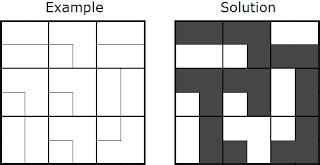Here's again one of Naoki Inaba's genres. It has some similarities to the Windows genre, which featured in the WPC, which can also be found on Naoki Inaba's website. It's known as conect on his website, but I don´t find that a very nice name. I changed it to Parquet as the grids reminded me of the Parquet Sudokus.
The puzzle worked out really nicely in my opinion, utilising all rules as well as possible on a 10x10 grid.
Rules for Parquet
Tuesday, 24 July 2012
Rules: Parquet
This genre was developed by Naoki Inaba.
Colour one of two regions in every blackbordered 2x2 area to form a single contiguous shape. This shape doesn't have any 2x2 coloured sections anywhere. Also this shape doesn't form any loops anywhere.
Colour one of two regions in every blackbordered 2x2 area to form a single contiguous shape. This shape doesn't have any 2x2 coloured sections anywhere. Also this shape doesn't form any loops anywhere.
Thursday, 19 July 2012
LMI Practise : Logirace
A recent comment on my blog mentioned how Loop genres feature prominently on my blog. It's somewhat true as I am better at finding interesting things to do with loop genres. This weekend happens to be a puzzle test on Logic Master India named Logirace. This test features nothing but loop genres. Half of them are Nikoli Loop genres(Corral, Country Road, Masyu, Slitherlink and Yajilin), 3 less familiar genres (Dutch Loop, Tapa Loop and Dotted Loop) and 2 that are new to me(Border Loop and Comet). I figured I'd try to make a few examples of the less familiar ones. Some puzzles worked out better than others. I didn't like working with some of the genres so much. Hard to get them unique and nice. Especially the Comet and Dotted Loop have issues of there being a unique solution a lot in construction. But I think each puzzle will help a bit in preparing for the test, if that's what you're interested in. Otherwise just solve them for fun. It's what puzzling is really about.
You can find the puzzle below. If you want to see smaller examples, check the instruction booklet.
You can find the puzzle below. If you want to see smaller examples, check the instruction booklet.
Tuesday, 10 July 2012
Puzzle #122: Shakashaka
I haven't seen how the Nikoli puzzles of this genre tend to look like, but I expect mine are a bit different. I prefer to keep the amount of clues as low as possible and make the open areas resolve themselves. I figure my puzzles tend to be on the harder side because of that. I like how it turned out. I was planning on doing a 1-2 antisymmetric clue pattern, except the 3 forced itself and I liked how the puzzle went till that point. So this is how it ended up.
Rules for Shakashaka
Rules for Shakashaka
Thursday, 5 July 2012
Puzzle #121: Heyawake; Symmetry
I had first seen this variant on Mathgrant's blog. I thought it worked nicely. So I figured I'd give it a go too. It wasn't the easiest to start as Symmetry is always a weakness for me when solving. It doesn't really register with me too well, usually. But then I got the idea to bring back the Antisymmetry label, which I had added to Puzzle #1, but hadn't used since. I always like to build in some kind of antisymmetry in the givens of my puzzles, except it somehow had never come back in any of my puzzles for my blog. So for this puzzle rotationally symmetrical cages with clues have the opposite clues given. This doesn't hold for cages without givens. It would have been cool if it did, but I think that would be awfully difficult to accomplish.
I think the puzzle worked out in the end. The one cell pairs were to fix uniqueness issues, which didn't really bother the solving path. Enjoy.
Rules for Heyawake
Follow normal Heyawake rules. Additionally, this puzzle has no numbers as clues. Instead the clues indicate if a room has 180 degree rotational symmetry or not. An S indicates that the room has 180 degree rotational symmetry. An A indicates that the room does not have 180 degree rotational symmetry.
I think the puzzle worked out in the end. The one cell pairs were to fix uniqueness issues, which didn't really bother the solving path. Enjoy.
Rules for Heyawake
Follow normal Heyawake rules. Additionally, this puzzle has no numbers as clues. Instead the clues indicate if a room has 180 degree rotational symmetry or not. An S indicates that the room has 180 degree rotational symmetry. An A indicates that the room does not have 180 degree rotational symmetry.
Tuesday, 3 July 2012
Puzzle #120: Line of Sight
I still enjoy making these puzzles. It's not the easiest to create openings, so they end up somewhat similar. But once you get going, it's really fun to play around with. This puzzle is of medium difficulty. I've made a few harder ones, but still some trickier points.
Rules for Line of Sight
Rules for Line of Sight
Subscribe to:
Comments (Atom)




